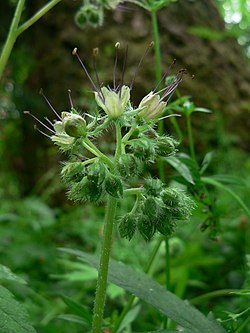| Hydrophyllum tenuipes | |
|---|---|
 | |
| Scientific classification | |
| Kingdom: | Plantae |
| Clade: | Tracheophytes |
| Clade: | Angiosperms |
| Clade: | Eudicots |
| Clade: | Asterids |
| Order: | Boraginales |
| Family: | Boraginaceae |
| Genus: | Hydrophyllum |
| Species: | H. tenuipes |
| Binomial name | |
| Hydrophyllum tenuipes | |

Hydrophyllum tenuipes, Pacific waterleaf or slender-stemmed waterleaf [1] , is an herbaceous perennial plant native to North America. It is found in western North America from British Columbia to northern California.